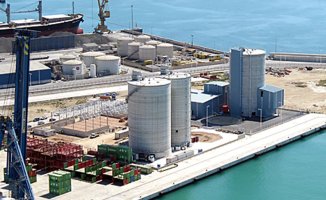Historical and triangular agreement to save Mes Aynak, a fundamental archaeological site, more than 2,000 years old and right on the Silk Road. The Afghan government, the Geneva-based International Alliance for the Protection of Heritage in Conflict Areas (ALIPH) and the Aga Khan Trust for Culture (AKTC) will urgently undertake work to protect the site, some 40 kilometers to the south of Kabul and under which there is a rich copper deposit whose exploitation was granted to a Chinese company. Beijing, a key player, is aware of the agreement. The Taliban government planned to make the pact public at the end of this week through the Undersecretary for Information and Culture, Mawlavi Atiqullah Azizi.
Mes Aynak has withstood the passing of centuries, the Taliban and Al Qaeda. The next to arrive was the China Metallurgical Group Corporation, which in 2007 signed an agreement with the Afghan government to mine the site for a period of 30 years. Copper will only be profitable (or more profitable) if the mine is open pit and not in a gallery, so the place will be devastated.
The political and military instability in the region has prevented the start of mineral extraction for now, but the US march in August 2021 has reactivated the Chinese plans, and in parallel the alarm of the international cultural community.
Aliph, with the support of the AKTC, has managed to get the Taliban and the Chinese to agree to buy some time. Before it starts to snow, towards the end of this month, it is expected to have protected the main monuments of the 45-hectare site, where temples, stupas, wall paintings, Buddha statues, Zoroastrian temples and industrial utensils of exceptional interest were found.
All this was saved from the wrath of the Taliban, which in 2001 annihilated the fabulous monuments of Bamiyan (from the 6th century AD), just 220 kilometers away. The place also surpassed having been an al Qaeda military camp.
Copper was probably what made the Mes Aynak site appear. It flourished between the 1st centuries B.C. and VII AD, precisely as a place of Buddhist pilgrimage connected with Bamiyan, and as an intermediate point on the Silk Road; This linked Chinese cities with Istanbul and Europe through different variants through Central Asia.
Mes Aynak was not discovered in contemporary times until the 1970s. It is considered the most important archaeological find in the last forty years in the world.
Kabul, Aliph and the AKTC must make a first investment in the near future for the most urgent tasks, which will be carried out on the ground by AKTC teams. Its general director, Luis Monreal from Barcelona, highlighted in a telephone conversation that “there has been a great change in the attitude of the Taliban regarding cultural heritage. After entering Kabul on August 15, 2021, one of the first things they did was protect the National Museum, and now they have done a lot to protect Mes Aynak. Unfortunately we cannot say the same about their attitude towards women, who are not even allowed to go to public parks”.
“Until now – Monreal continues – we have collected all possible mobile material, which has been sent to the Kabul museum. The buildings remain. The action plan should take into account the fragility of some materials. We are not talking about stone like in Nubia but a lot of adobe material, and there is a lot of monumental sculpture attached to it. It will be necessary to think about whether to create a museum in Mes Aynak or to take it further. These are issues to be resolved."
The protection works, in fact, began a few days ago, although the official announcement has not been made until now, in the absence of official ratification and confirmation from Beijing.
For now, the places of greatest interest will be protected from the inclemencies of winter, while a possible international rescue operation is studied in the style –although to a lesser extent– of the one Unesco carried out in the 1960s and which allowed the transfer of the temples of Abu Simbel, in Egyptian Nubia, due to the works of the Aswan dam.
Before a possible transfer, the works will consist of the study of the documentation generated in archaeological excavations undertaken in recent years, the production of 3D materials to have a complete record of the site, the construction of temporary structures and a new system drainage, shoring up and consolidating archaeological and architectural remains and beginning the transfer and safe storage of frescoes, sculptures and pieces of the ensemble. An international team of scientific experts will advise the works.
On the ground, the project will generate employment for some 200 people, residents of the surrounding area. In the philosophy that the AKTC applies to all its projects, it is the local population who undertakes them, after a period of specific training in the required trades, such as masonry, electricity, joinery, carpentry, conservation...
“It will take two or three years of work”, adds Monreal, “and the project will require not only the participation of Aliph, as the main partner of the project, but we will have to seek the intervention of other actors or specialized institutions from different countries. In this case it is a diplomatic challenge, given the embargo to which the country is subjected. We will have to see which institutions in the world can get involved in this ambitious operation, perhaps they will not be Western but from countries that have influence in the area, such as China or India, and that do not have the same obstacles to collaborating with the Taliban”.
"In any case, it is essential to negotiate with the Chinese government and with the mining company, to try to establish deadlines and areas of action that are beneficial to all parties," he adds. The order of exploitation that China imposes on the ground will be key. Mes Aynak is the second largest known copper deposit in the world, and the areas where there is mineral exceeds those of the archaeological field. It is estimated that, given its nature, the mining company could collaborate in the logistics of the operation.
Aliph was born in 2017 as a response to the destruction of heritage due to terrorism or wars in areas of the Middle East or the Sahel. It started with seven partner countries – including Saudi Arabia, with great financial capacity – and three private donors. Before Mes Aynak, Aliph has supported 180 projects in 30 countries on 4 continents.
Mes Aynak was since 1999 a training camp for Al Qaeda. The Russians had already mined copper there, and the existing structures and buildings served as a hideout for Osama bin Laden's acolytes. They settled there after the Americans destroyed the Khost camp, and it was the only asset until the Taliban agreed to the construction of Al Farouq, near Kandahar. Saif al-Adel, one of the terrorists who attacked the ship USS Cole on October 12, 2000, while it was docked, came out of Mes Aynak, as established by the 9/11 commission created by the United States Congress. in the port of Aden, in Yemen. 17 American soldiers died.













